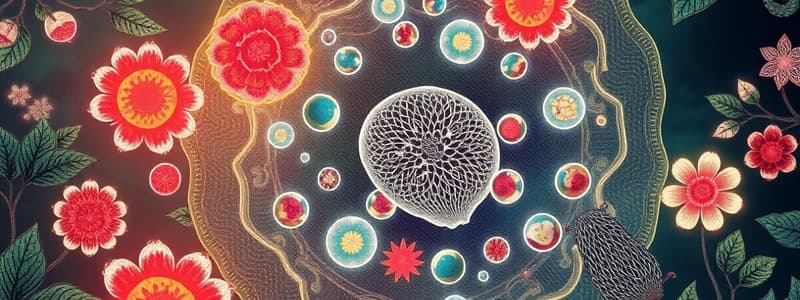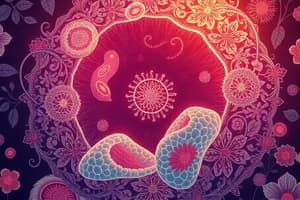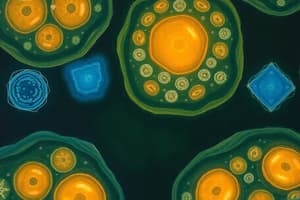Podcast
Questions and Answers
Which organelle is responsible for processing, packaging, and distributing proteins and lipids in both plant and animal cells?
Which organelle is responsible for processing, packaging, and distributing proteins and lipids in both plant and animal cells?
- Nucleus
- Mitochondria
- Golgi Apparatus (correct)
- Endoplasmic Reticulum
What is the primary function of ribosomes in cells?
What is the primary function of ribosomes in cells?
- Cell division
- Energy production
- Lipid metabolism
- Protein synthesis (correct)
What structure in plant cells provides additional structural support that is not found in animal cells?
What structure in plant cells provides additional structural support that is not found in animal cells?
- Nuclear membrane
- Cytoskeleton
- Cytoplasm
- Cell Wall (correct)
Which organelle is known as the powerhouse of the cell for producing ATP?
Which organelle is known as the powerhouse of the cell for producing ATP?
Which of the following is a shared feature of both plant and animal cells?
Which of the following is a shared feature of both plant and animal cells?
Which organelle is responsible for photosynthesis in plant cells?
Which organelle is responsible for photosynthesis in plant cells?
What is the primary function of the large central vacuole in plant cells?
What is the primary function of the large central vacuole in plant cells?
Which of the following organelles is found only in animal cells?
Which of the following organelles is found only in animal cells?
Which feature differentiates the cell wall of plant cells from animal cells?
Which feature differentiates the cell wall of plant cells from animal cells?
Which of the following statements about vacuoles is true?
Which of the following statements about vacuoles is true?
Flashcards
Plant Cell Wall
Plant Cell Wall
A rigid outer layer primarily composed of cellulose, providing structural support to plant cells.
Plant Chloroplast
Plant Chloroplast
The site of photosynthesis in plant cells, converting light energy into chemical energy (sugars).
Animal Lysosome
Animal Lysosome
An organelle that contains enzymes for intracellular digestion in animal cells.
Plant Central Vacuole
Plant Central Vacuole
Signup and view all the flashcards
Animal Centriole
Animal Centriole
Signup and view all the flashcards
Plant Plasmodesmata
Plant Plasmodesmata
Signup and view all the flashcards
Plant Cell Wall Composition
Plant Cell Wall Composition
Signup and view all the flashcards
Plant vs. Animal Cells - Cell Wall
Plant vs. Animal Cells - Cell Wall
Signup and view all the flashcards
Secondary Cell Wall
Secondary Cell Wall
Signup and view all the flashcards
Cytoskeleton
Cytoskeleton
Signup and view all the flashcards
Ribosomes
Ribosomes
Signup and view all the flashcards
Endoplasmic Reticulum (ER)
Endoplasmic Reticulum (ER)
Signup and view all the flashcards
Mitochondria
Mitochondria
Signup and view all the flashcards
Study Notes
Plant Cell Organelles
- Plant cells are eukaryotic cells, characterized by a rigid cell wall composed primarily of cellulose, providing structural support.
- Plant cells contain chloroplasts, the sites of photosynthesis, essential for converting light energy to chemical energy in the form of sugars.
- Plant cells often have a large central vacuole, maintaining turgor pressure and storing various substances.
- Plasmodesmata are channels connecting adjacent plant cells, facilitating communication and transport of materials.
- Amyloplasts, specialized plastids, are involved in starch storage.
- Plant cells possess a secondary cell wall, located outside the primary cell wall, providing additional support.
Animal Cell Organelles
- Animal cells are also eukaryotic cells, but they lack a rigid cell wall.
- Animal cells do not contain chloroplasts or plastids due to their reliance on external food sources for energy.
- Animal cells possess lysosomes, which contain hydrolytic enzymes and are crucial for intracellular digestion.
- Animal cells often have smaller vacuoles, serving various functions such as storage and transport.
- The presence of centrioles is a defining feature, involved in cell division and organizing the cytoskeleton.
Comparison of Organelles
- Cell Wall: Present in plant cells (composed of cellulose), absent in animal cells.
- Chloroplasts: Present in plant cells, essential for photosynthesis, absent in animal cells.
- Central Vacuole: Large central vacuole in plant cells, maintaining turgor pressure and storing substances, absent or much smaller in animal cells.
- Plasmodesmata: Present in plant cells, facilitating cell-to-cell communication and transport, absent in animal cells.
- Lysosomes: Present in animal cells, involved in intracellular digestion, absent in plant cells (functions of lysosomes are performed primarily by vacuoles).
- Centrioles: Present in animal cells, play a role in cell division and organization of the cytoskeleton, absent in plant cells (a few plant species have centrioles though).
- Vacuoles: Vary in size and number across cell types. Plant cells usually having one large central vacuole, while animal cells typically have smaller and more numerous vacuoles.
- Amyloplasts: Present in plant cells for starch storage, absent in animal cells.
- Plastids: Generally found in plant cells (e.g., chloroplasts, chromoplasts, leucoplasts), absent in animal cells.
- Secondary Cell Wall: Often present in plant cells, providing additional structural support, absent in animal cells.
- Cytoskeleton: Found in both plant and animal cells; it is essential for maintaining cell shape, facilitating intracellular transport, and cell movement.
- Ribosomes: These organelles are found in the cytoplasm of both types of cells and are responsible for protein synthesis.
- Endoplasmic Reticulum (ER): Found in both plant and animal cells; it's a network of membranes involved in protein synthesis, lipid metabolism, and calcium storage.
- Golgi Apparatus: Found in both plant and animal cells; it is responsible for processing, packaging, and distributing proteins and lipids.
- Mitochondria: Found in both plant and animal cells; they are the powerhouse of the cell and produce ATP through cellular respiration.
- Nucleus: Present in both plant and animal cells; it contains the cell's genetic material (DNA).
- Nuclear membrane: Both cell types contain a nuclear membrane that separates the nucleus from the cytoplasm, protecting the genetic material.
Studying That Suits You
Use AI to generate personalized quizzes and flashcards to suit your learning preferences.




